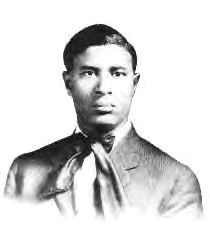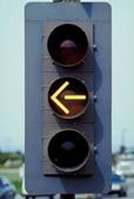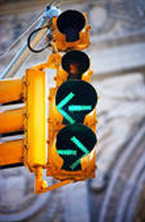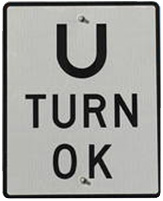 Traffic lights are devices placed along, beside or above a highway, roadway or other routes to regulate the flow of traffic, including motor vehicles, bicycles and pedestrians. The most common type of traffic light has three lenses however some have two, depending on what it is regulating. The position of the three colored-lenses on most traffic lights is red on top, yellow in the middle and green on the bottom. The sequence in which they are lighted is green to yellow, yellow to red and red to green.
Traffic lights are devices placed along, beside or above a highway, roadway or other routes to regulate the flow of traffic, including motor vehicles, bicycles and pedestrians. The most common type of traffic light has three lenses however some have two, depending on what it is regulating. The position of the three colored-lenses on most traffic lights is red on top, yellow in the middle and green on the bottom. The sequence in which they are lighted is green to yellow, yellow to red and red to green.
Who Invented The Traffic Light
While I was waiting for the light to turn green, my mother chose once again to test my knowledge, this time by asking me if I knew who invented the traffic light. I think you can recall how the rest of this conversation went from my previous article entitled “In a Nutshell,” so why don’t we move on to the business at hand, which is my telling you what I found out about this particular invention and the man behind it.
 Garrett Augustus Morgan was born in Paris, Kentucky on March 4, 1877. Morris started working at the age of 14 after 6 years of schooling. His interest in mechanics was sparked by a job as a sewing-machine adjuster for a clothing manufacturer. He received wide recognition for his outstanding contributions to public safety. In 1923, Morgan received a patent for his new concept (U. S. 1,475,024 issued in 1923) a traffic signal to regulate vehicle movement in city areas. GO and STOP signs were systematically raised and lowered at intersections to bring order out of the chaos of regulating pedestrian and vehicle traffic on city streets. In years that followed his invention, after he sold it to the General Electric Company for $40,000, he received patents in England and Canada for similar signal devices. Morgan’s inventions were eventually replaced with the light signal devices used today. In addition to the traffic light, Garrett Morgan also invented the safety helmet and the gas mask, which firefighters in many cities in the early 1900’s wore, and for which he was awarded a gold medal at the Second International Exposition of Safety and Sanitation in New York in 1914. The gas mask Morgan invented in 1912 (U. S. 1,113,675 issued in 1914) was used during World War I to protect soldiers from chlorine gas fumes. In 1916, Mr. Morgan used his own mask design to rescue men trapped by a gas explosion in a tunnel being constructed under Lake Erie. Following this disaster, which killed twenty-one people, the City of Cleveland, Ohio honored Garrett Morgan with a gold medal for his heroic efforts. Morgan was known as an astute businessman and started business enterprises with many of his inventions, including a tonic for straightening hair, a preparation which he marketed under the name G. A. Morgan Hair Refining Cream. Morgan also published the Cleveland Call, a weekly newspaper devoted to news about the African American community. Morgan received a U.S. government citation for his traffic signal and a First Grand Prize Golden Medal by the National Safety Device Company at the Second International Exposition of Safety and Sanitation in 1914, among other honors and awards. Garrett Augustus Morgan died on August 27, 1963.
Garrett Augustus Morgan was born in Paris, Kentucky on March 4, 1877. Morris started working at the age of 14 after 6 years of schooling. His interest in mechanics was sparked by a job as a sewing-machine adjuster for a clothing manufacturer. He received wide recognition for his outstanding contributions to public safety. In 1923, Morgan received a patent for his new concept (U. S. 1,475,024 issued in 1923) a traffic signal to regulate vehicle movement in city areas. GO and STOP signs were systematically raised and lowered at intersections to bring order out of the chaos of regulating pedestrian and vehicle traffic on city streets. In years that followed his invention, after he sold it to the General Electric Company for $40,000, he received patents in England and Canada for similar signal devices. Morgan’s inventions were eventually replaced with the light signal devices used today. In addition to the traffic light, Garrett Morgan also invented the safety helmet and the gas mask, which firefighters in many cities in the early 1900’s wore, and for which he was awarded a gold medal at the Second International Exposition of Safety and Sanitation in New York in 1914. The gas mask Morgan invented in 1912 (U. S. 1,113,675 issued in 1914) was used during World War I to protect soldiers from chlorine gas fumes. In 1916, Mr. Morgan used his own mask design to rescue men trapped by a gas explosion in a tunnel being constructed under Lake Erie. Following this disaster, which killed twenty-one people, the City of Cleveland, Ohio honored Garrett Morgan with a gold medal for his heroic efforts. Morgan was known as an astute businessman and started business enterprises with many of his inventions, including a tonic for straightening hair, a preparation which he marketed under the name G. A. Morgan Hair Refining Cream. Morgan also published the Cleveland Call, a weekly newspaper devoted to news about the African American community. Morgan received a U.S. government citation for his traffic signal and a First Grand Prize Golden Medal by the National Safety Device Company at the Second International Exposition of Safety and Sanitation in 1914, among other honors and awards. Garrett Augustus Morgan died on August 27, 1963.
Traffic Light Signals
A solid red light means to stop completely behind the limit line, crosswalk, or before entering the intersection.
- You must wait for a green light to proceed, with the following exceptions:

- A right turn may be made on a solid red light after you have yielded to all traffic and pedestrians and if a “NO TURN ON RED” sign is not posted.
- If there are no signs prohibiting it, you may turn left on a red light if you are both turning from and turning into a one-way street, after you yield the right-of-way to pedestrians within the adjacent crosswalk and traffic using the intersection.
A solid yellow traffic light means that the light will soon change to red.
- When you see a yellow light, you should slow down and stop before entering the intersection if you can do so safely.

- You should not enter an intersection when the light has changed to yellow, unless you cannot stop safely before doing so.
- If you must enter an intersection on a yellow light, it is important to watch out for cross traffic and vehicles starting right or left turns that might enter the intersection when the light changes.
A yellow arrow means that you should be prepared to obey the next signal that appears, which could be a solid green or red light, or a red arrow.
- If the yellow arrow is horizontal, it means that your protected turning period (during which all oncoming traffic is stopped by red
 lights) is about to end.
lights) is about to end. - Horizontal yellow arrows are used to control traffic in left or right turn lanes.
- Vertical yellow arrows are used to control straight-through traffic for a specific lane.
- If you cannot stop safely before entering the intersection on a yellow arrow, it is important to watch out for cross traffic and drivers starting right or left turns that might enter the intersection when the light changes.
 A green light means that you may proceed straight through or make a turn as noted below after the intersection is cleared of vehicles, bicycles and pedestrians.
A green light means that you may proceed straight through or make a turn as noted below after the intersection is cleared of vehicles, bicycles and pedestrians.
- You may make a right, left turn or U turn on a green light, unless a sign prohibits it. You must yield the right-of way to oncoming vehicles and bicycles and pedestrians crossing the street that are close enough to pose a hazard.
- Do not enter an intersection, even when the light is green, unless there is enough space to completely cross the intersection before the light turns red. If heavy traffic causes you to block cross traffic, you can be cited for causing gridlock.
A green arrow means that you may proceed in the direction that the arrow points (i.e., left, right, or straight), after you yield the right-of- way to any vehicle, bicycle or pedestrian still in the intersection.
way to any vehicle, bicycle or pedestrian still in the intersection.
- Horizontal green arrows are used to control traffic in left or right turn lanes.
- A horizontal green arrow pointing to the left or right means that you may make protected turn.
- Vertical green arrows are used to control straight-through traffic in a specific lane.
 Arrows in the shape of an upside-down U are used to control lanes of traffic that may make U turns only. You should obey red,
Arrows in the shape of an upside-down U are used to control lanes of traffic that may make U turns only. You should obey red,  yellow and green U-turn only arrows in the same way that you would obey horizontal arrows of the same color.
yellow and green U-turn only arrows in the same way that you would obey horizontal arrows of the same color.- A flashing red signal light has the same meaning as a stop sign.
- You must stop completely behind the limit line, crosswalk or intersection. Yield the right-of-way to vehicles and pedestrians in the intersection before you proceed.
- Flashing red lights that are not traffic signals are sometimes used to warn you of an upcoming stop sign, railroad crossing, an upcoming signal light, pedestrian crossing, school zone or construction zone.
- Traffic signal lights that are malfunctioning will sometimes flash red.
- Flashing lights also regulate areas that are of caution, to yield to other vehicles. This is to make drivers aware to the potential hazard.
- A flashing yellow light is a warning to slow down and be especially alert.
- A yellow light or arrow warns the driver that the red light is about to appear.
- When a driver sees the yellow light or arrow, they should stop if they are able to do so safely
- If the driver cannot stop, they need to be aware and to look for vehicles or pedestrians that may enter the intersection when the light changes to red.
- If all traffic signal lights at an intersection are not working because of an electrical power failure, you must stop at the intersection behind the limit line, crosswalk or at the corner.
- A blacked-out traffic signal should be treated the same as a stop sign.
- You should only proceed when you know that all other turning and approaching vehicles, bicycles and pedestrians will also be stopping.
- When traffic lights are erected at places other than an intersection (such as a crosswalk in the middle of a block or highway), you must obey the traffic signal. For red lights you must completely stop at the limit line, crosswalk, a special sign or at the signal itself.
- Sometimes traffic lights are used to control certain lanes of traffic at places other than intersections. For example, traffic lights are sometimes used to control vehicles at toll plazas and freeway on ramps. The light configurations at these places do not always include a yellow light; sometimes they go from red to green. These traffic lights must also be obeyed.

- Traffic signal automated enforcement devices (red light cameras) may legally be placed at limit lines, intersections, or other places where you are required to stop (including railroad crossings). The presence of the camera is clearly identified by signs in all directions, or posted at major entrances to a city. You have the right to see photographic evidence of the violation.
- To help freeway traffic flow, some on-ramps and freeway interchanges are regulated by lane controls, which only allow a certain number of cars to enter the freeway at varying time intervals.
- This is called “staggering.”
- The lights on these signals change very quickly.
- You may only proceed when the light turns green. If there is more than one acceleration lane, there will be more than one lane control signal, although carpool lanes will usually not be regulated.
- These signals usually have a sign that indicates the number of cars that may proceed when the light turns green (e.g., two cars per lane may proceed for each green light).
Designated Lanes
To control the direction and the flow of the vehicles through the intersection, there will be designated lanes that must go right, forward and left.


